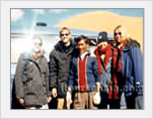
Tiananmen
- Travel to TiananmenTiananmen which means 'Gate of Heavenly Peace' in Chinese, was first built in 1417 as a centerpiece entry to the middle layer of three concentric walled enclosures defining the urban expression of the Ming dynasty's (1368-1644) capital city. It was called Chengtianmen during the Ming dynasty. At the end of the dynasty, when the peasant leader Li Zicheng, who had defeated Ming forces, was driven out by Qing troops, many buildings were destroyed. Chengtianmen got burned down, leaving only the foundation of its walls. In 1651, under the Qing Emperor Shunzhi, the gate tower was rebuilt in the original style and renamed Tian'anmen -- the Gate of Heavenly Peace. Today it retains the basic character of the early Qing gate. Just before the southern entrance to Tian'anmen, seven arched bridges, shaped like curving jade belts, cross the Golden River (Jinshuihe). The central bridge is slightly wider than the rest and forms part of the Imperial Way -- the path over which only the emperor could pass. One of the more unusual features of Tian'anmen is a pair of 10-meter-high white marble columns (huabiao) topped by a "dish for collecting dew."
A carved stone animal known as a "heaven-gazing hou" squats inside each dish. These dishes were used to catch the "jade dew" imbibed by the emperor to ensure long life. According to the legend. The "heaven-gazing hou" watched over the emperor's activities when he was away from the palace, hoping he would not overindulge in his pleasures. Tian'anmen also served as the site for proclamations of state celebrations such as the enthronement of an emperor imperial marriages. From 1945 to 1949, Tian'anmen was frequently the meeting place for members of progressive student movements, an undying legacy to this day. In 1949, Tian'anmen regained its former grandeur through a complete renovation. The square has been widened to 40 hectares and is now one of the largest public squares in the world.
Entry ticket for the rostrum: 15 yuan;
Address: On the Chang’an Boulevard, west of Wangfujing.
Tiananmen Tour
More ToursYour Question & Quick Answer*Design Your Own Trip
Beijing Top Attractions
Beijing Travel Information
Our Service
Booking Procedures | Terms & Conditions | Payment Methods | Links | Site Map | About Us | Contact Us | Travel Agent
Copyright 2008, All rights reserved.. itourbeijing.com professional Beijing tour operator and China travel service
TEL: 86-10-85711972 (Universal) 1-888-288-9328 (North America) E-mail: contact@itourbeijng.com
Tours Index | China Tours | Beijing Tours | Xi'an Tours | Shanghai Tours | Guilin Tours | Tibet Tours
China Travel | Beijing Travel | Shanghai Travel | Xi'an Travel | Guilin Travel |The Great Wall Tours
China Golf | Beijing Golf | Shanghai Golf | Xiamen Golf | Beijing Map | Beijing Side Trip | Yangtze Cruise | Travel Picture



